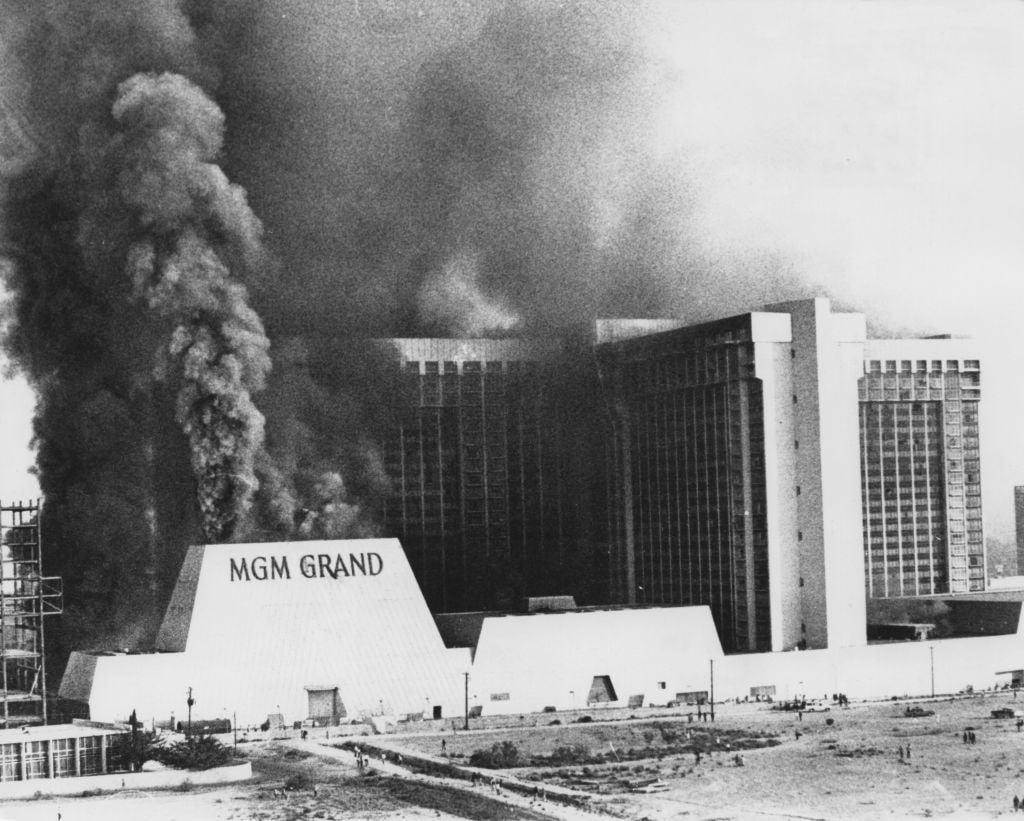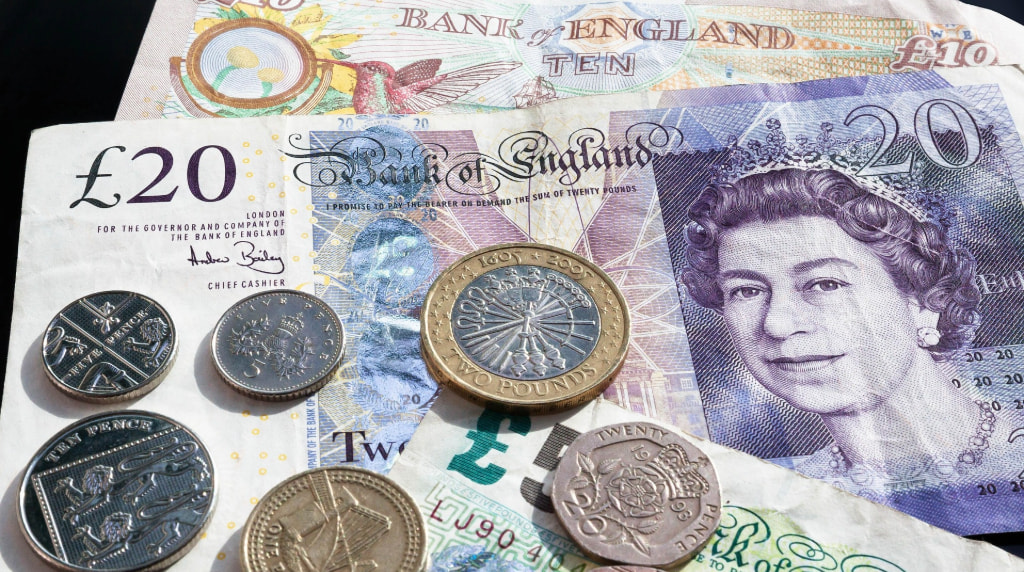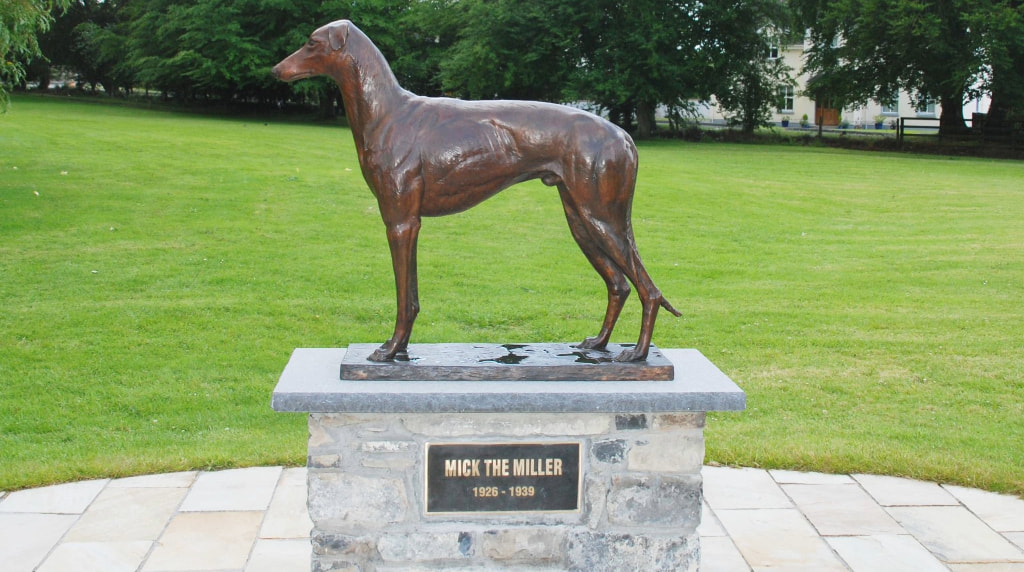Las Vegas and Nevada Has Had Its Share of Catastrophes
Sized 110,571 square miles, Nevada is a massive place. Nicknamed ‘the Silver State’, it is larger than the UK and almost the size of Spain. It is the driest state in the United States, but that term does not refer to the consumption of alcohol or the ability to gamble.
Nevada has over 450 large casinos stretching far beyond the famous Las Vegas Strip. Laughlin, Carson City, Ely, Henderson, Enterprise, Sparks, Winchester, and Reno are other gambling hotspots. While responsible gambling is heavily promoted, annually, gamblers lose $15 billion in these venues, and very few leave Nevada showing a profit on their gaming.

Smoke pours from the MGM Grand Hotel & Casino in Las Vegas at the height of a fire which killed 85 people. ©GettyImages
Others have been far more unfortunate. America’s seventh-largest state has had more than its fair share of disasters and human tragedies down the years. In 2017, Las Vegas was the scene of America’s largest mass shooting, which led to the death of 61 people with an additional 867 injured.
This item will reflect on some of Nevada’s darkest days. It is a list that includes man-made disasters, freak accidents, hideous crimes, environmental catastrophes, numerous air crashes and a sharp economic downturn that drove people to the brink.
Boomtown up in Flames
1875’s Great Fire of Virginia City is one of the most devastating wildfires in Nevada’s history. Damage to the silver-mining boomtown, which sprang up in 1859, destroyed 2,000 structures, including homes, churches, saloons, businesses, and mining buildings. Three hundred people were left homeless, and rioting ensued. While lives were not lost, the fire, which started accidentally, was estimated to have caused between $7-10 million in damage.
Deaths at the Hoover Dam
The Hoover Dam is recognised as one of America’s modern civil engineering wonders. Opened in 1936, the dam’s generators continue to provide power for public and private utilities in Nevada, Arizona, and California. It is a significant tourist attraction, with seven million visitors a year.
However, its construction was deadly, and during the five years that it was built – in the middle of the Great Depression – at least 96 construction workers were killed. Accidents and heat exhaustion were attributed as the principal cause. An additional 42 workers were recorded as having died from pneumonia, which workers alleged was a diagnosis to cover up fatal carbon monoxide poisoning.
24 Dead in Mystery Train Crash
On August 12, 1939, a glamorous streamliner steam train, the ‘City of San Francisco’, derailed near Harney, Nevada. Twenty-four people were killed and 121 were injured. The derailment was caused by sabotage of the tracks. Despite a $5,000 reward (later increased to $10,000) and years of investigation, those responsible for the crash were never identified.
Off Course TWA Flight Kills 22
All 22 on board perished when a TWA Douglass DC-3 crashed into a cliff 15 minutes after taking off from Las Vegas Airport. The year was 1942, and amongst those killed was screen actress Carole Lombard. She was the highest-paid actress in Hollywood and married to Clark Gable.
It was reported Lombard had flipped a coin to take a seat on the plane – the alternative was a train journey. A subsequent investigation recognised safety beacons usually used to direct night flights had been turned off. It left the pilot and crew of the twin-engine craft without visual warnings of the mountains in their flight path.
One Survives a Second DC-3 Crash
Four years later, a second Douglas DC-3 met with disaster in Nevada, this time killing 21. Tragedy struck when the craft attempted to land in dense fog at Elko Airport. Miraculously, there was one survivor – a three-year-old boy who was thrown clear of the burning wreckage.
Nuclear Testing
While not a catastrophe in the traditional disaster sense, the Nevada Test Site northwest of Las Vegas was the location for numerous nuclear tests during the Cold War. Between 1951 and 1992, the US government conducted a total of 928 nuclear tests here. Of these, 100 were atmospheric, and 828 were underground. Long-term environmental and health effects have followed.
A 1990 Radiation Exposure Compensation Act allowed people living downwind of the site for at least two years (between January 1951 and October 1958 or in July 1962) and suffering from certain cancers or other serious illnesses deemed to have been caused by fallout exposure to receive compensation. By July 2024, over 28,863 compensation claims for ‘downwinders’ had been processed.
Hotspot Sees 134 Loves Lost
Nevada has been an air crash hotspot. In April 1958, a United States Air Force jet and a United Airlines jet flying between Los Angeles and New York City collided mid-air just west of Las Vegas. All on board both planes, 49 people, lost their lives.
A subsequent inquiry found neither crew was negligent for a failure to see and avoid each other. The crash site was originally unpopulated desert land but has since been developed. Remarkably, there is no permanent memorial to those who perished.
The most significant loss of life involving an aircraft in Nevada happened in March 1964 when a ‘Paradise Airlines’ Lockheed Constellation that had taken off in San Jose, California, attempted to land at Tahoe Valley Airport. It crashed during a snowstorm, killing all 85 people aboard.
Killer Drive on Reno Sidewalk
Transportation of a different kind took the lives of six and injured an additional 23 on Thanksgiving Day 1980 in Reno. It was the day Priscilla Ford, a woman suffering from paranoid schizophrenia, drove her Lincoln Continental car down a crowded sidewalk, mowing down pedestrians in the process. Ford spent almost 25 years on death row before she died of complications from emphysema in 2005, aged 75.
The Deadliest Fire in Vegas
1980 also produced the deadliest fire in Nevada history and the third-deadliest hotel fire in modern US history. On November 21, an estimated 5,000 people were in Las Vegas MGM Grand – now one of the world’s biggest hotels – but then a seven-year-old casino and 26-story hotel with more than 2,000 rooms.
Six minutes after the deadly fire – started by a faulty refrigerated pastry display case – was discovered, the entire casino floor was engulfed in flames. Thankfully, the fire never travelled beyond the first floor, but toxic fumes and smoke ascended and entered people’s rooms. Resultantly, 75 of the 85 people killed succumbed to smoke inhalation.
Busboy Behind the Vegas Hilton Blaze
Eighty-one days after the MGM fire, another Las Vegas hotel fire broke out. This time, the tragedy happened at the Las Vegas Hilton, where Philip Cline, a hotel busboy who was under the influence of drugs, set fire to a curtain in an elevator lobby on the eighth floor of the hotel’s east tower.
The blaze spread rapidly and, reaching the top floor, took a long time to control. Resultantly, 48 firefighters were among the 350 people injured. Miraculously, only eight people were killed.
Plane Tragedy After a Fun Weekend
On January 21, 1985, a Galaxy Airlines flight carrying 72 people who were returning from a casino gambling and Super Bowl betting junket crashed shortly after take-off near Reno Airport. Pilot and ground staff error was blamed for the tragedy. Miraculously, once again, a single person survived – a 17-year-old boy, George Lamson Jr., who walked away from the wreckage almost unharmed.
2008’s Great Recession Hit Hard
The economic downturn of 2008, often referred to as the Great Recession, had a significant impact on Nevada due to the state’s heavy reliance on the tourism, gambling, and construction industries. Nevada, especially Las Vegas, was one of the epicentres of the housing bubble, and when it burst, it led to one of the highest foreclosure rates in the nation.
Property values plummeted, leaving many homeowners in arrears on their mortgage payments. Furthermore, Nevada saw a dramatic rise in unemployment with massive layoffs in all sectors. The factors combined to see suicide rates in Nevada – already well above the countrywide average – soar in the following few years.
For the age group 60-85, Nevada remains listed among the top five of the states with the highest average suicide rates in the United States. Nevada’s suicide rate for this age bracket is 69 percent higher than the national average.[1]
Nightmare Crash at 2011 Air Race
On September 16, 2011, 11 people died (including the pilot), and 69 were injured when a vintage WWII-era P-51 Mustang air racer crashed into spectators during a horrifying disaster at the National Championship Air Races in Reno. The Galloping Ghost hit the ground at 400 miles-per-hour, filmed by stunned and horrified onlookers.
Investigators declared the crash’s probable cause was the loosening of nuts on the left elevator trim tab system. Unbelievably, 41 years earlier, the same aircraft – then known as Miss Candice – had crashed while attempting an emergency landing at the same event at the same airport.
Mass Murder at Mandalay Bay
The 2017 Route 91 Harvest music festival shooting has faded from the public psyche alarmingly quickly. The largest mass shooting in the history of the USA killed 58 people at the scene or shortly afterwards. Another three have since died as a result of complications of their injuries.
No other US shooting has resulted in more than 60 injuries. The madness of 64-year-old Stephen Paddock, who fired more than 1,000 rounds from his 32nd-floor suites in the Las Vegas Mandalay Bay Hotel, resulted in 867 innocent people being injured.
The events of the fateful evening and the aftermath of this mass murder were captured by a 2020 Journeyman documentary titled, ‘Money Machine’. Since its making, the proceeds from Paddock’s assets – including two homes, an investment property in Nevada, a vehicle, and 49 guns valued at $1.3 million – have been distributed to the families of 61 victims.
The Heat Is Always on in Nevada
Southern Nevada, where Las Vegas is located, is a hot spot in every sense. Statistics provided by Weatherspark.com show the hot season lasts for 3.4 months, from June 2 to September 15, when the average daily high temperature sits above 95°F (35°c). The hottest month of the year in Las Vegas is July, with an average high of 104°F (40°c).[2]
In the area, 2024 produced more heat-related deaths than any other year, and by the end of the ‘hot season’, officials confirmed that there had been 342 fatalities linked to the heat. An additional 2,277 people visited the emergency department for heat-related illness. It was Las Vegas’ hottest year on record – for seven straight days in July temperatures breached 115 degrees – but experts say it will get hotter in the future.
- Suicide – Age 65+ in United States, (December 5, 2023), America’s Health Rankings, Retrieved October 8, 2024.
- Climate and Average Weather Year Round in Las Vegas, (December 5, 2024), Weather Spark, Retrieved October 13, 2024.



